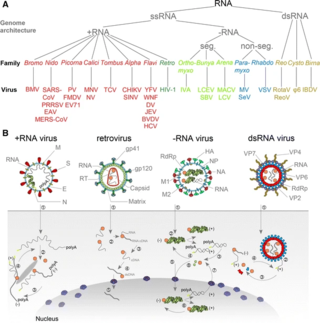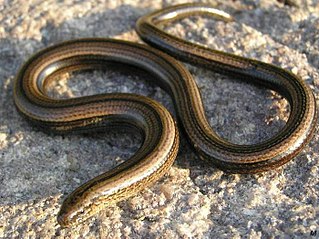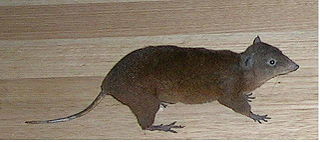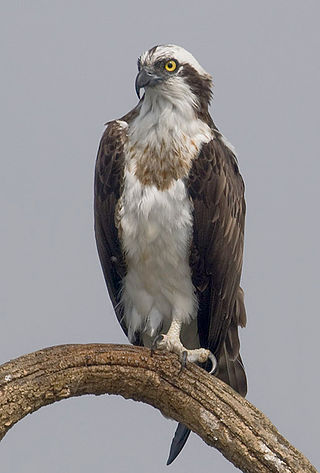Related Research Articles

An RNA virus is a virus—other than a retrovirus—that has ribonucleic acid (RNA) as its genetic material. The nucleic acid is usually single-stranded RNA (ssRNA) but it may be double-stranded (dsRNA). Notable human diseases caused by RNA viruses include the common cold, influenza, SARS, MERS, COVID-19, Dengue Virus, hepatitis C, hepatitis E, West Nile fever, Ebola virus disease, rabies, polio, mumps, and measles.

The Percidae are a family of ray-finned fish, part of the order Perciformes, which are found in fresh and brackish waters of the Northern Hemisphere. The majority are Nearctic, but there are also Palearctic species. The family contains more than 200 species in 11 genera. The perches and their relatives are in this family; well-known species include the walleye, sauger, ruffe, and three species of perch. However, small fish known as darters are also a part of this family.

The Rutaceae is a family, commonly known as the rue or citrus family, of flowering plants, usually placed in the order Sapindales.

A spirochaete or spirochete is a member of the phylum Spirochaetota, which contains distinctive diderm (double-membrane) gram-negative bacteria, most of which have long, helically coiled cells. Spirochaetes are chemoheterotrophic in nature, with lengths between 3 and 500 μm and diameters around 0.09 to at least 3 μm.

Anguidae refers to a large and diverse family of lizards native to the Northern Hemisphere. Common characteristics of this group include a reduced supratemporal arch, striations on the medial faces of tooth crowns, osteoderms, and a lateral fold in the skin of most taxa. The group is divided into two living subfamilies, the legless Anguinae, which contains slow worms and glass lizards, among others, found across the Northern Hemisphere, and Gerrhonotinae, which contains the alligator lizards, native to North and Central America. The family Diploglossidae was also formerly included. The family contains about 87 species in 8 genera.
In biology, a monotypic taxon is a taxonomic group (taxon) that contains only one immediately subordinate taxon. A monotypic species is one that does not include subspecies or smaller, infraspecific taxa. In the case of genera, the term "unispecific" or "monospecific" is sometimes preferred. In botanical nomenclature, a monotypic genus is a genus in the special case where a genus and a single species are simultaneously described. In contrast, an oligotypic taxon contains more than one but only a very few subordinate taxa.

The Plasmodiidae are a family of apicomplexan parasites, including the type genus Plasmodium, which is responsible for malaria. This family was erected in 1903 by Mesnil and is one of the four families in the order Haemospororida.

The Hypsiprymnodontidae are a family of macropods, one of two families containing animals commonly referred to as rat-kangaroos. The single known extant genus and species in this family, the musky rat-kangaroo, Hypsiprymnodon moschatus, occurs in northern Australia. During the Pleistocene, this family included the megafauna genus Propleopus.
Asteropeia is a genus of flowering plants. The genus contains 8 known species of shrubs and small trees, all endemic to Madagascar. It is the sole genus in family Asteropeiaceae. Members of the family are evergreen trees or shrubs.

Caudipteridae is a family of oviraptorosaurian dinosaurs known from the Early Cretaceous of China. Found in the Yixian and Jiufotang Formations, the group existed between 125 and 120 million years ago. Distinguishing characteristics of this group have been indicated as including a unique dagger-shaped pygostyle. In 2015, the group was defined as "the most inclusive clade containing Caudipteryx zoui but not Oviraptor philoceratops and Caenagnathus collinsi".

Legless lizard may refer to any of several groups of lizards that have independently lost limbs or reduced them to the point of being of no use in locomotion. It is the common name for the family Pygopodidae. These lizards are often distinguishable from snakes on the basis of one or more of the following characteristics: possessing eyelids, possessing external ear openings, lack of broad belly scales, notched rather than forked tongue, having two more-or-less-equal lungs, and/or having a very long tail.

Eustigmatophytes are a small group of eukaryotic forms of algae that includes marine, freshwater and soil-living species.

Pandion is a genus of fish-eating bird of prey, known as ospreys, the only genus of family Pandionidae. Most taxonomic treatments have regarded this genus as containing a single living species, separated into subspecies and found worldwide near water, while some treatments recognize two living species, splitting off the eastern osprey from Australia and southeast Asia.

Globuloviridae is a family of hyperthermophilic archaeal viruses. Crenarchaea of the genera Pyrobaculum and Thermoproteus serve as natural hosts. There are four species in this family, assigned to a single genus, Alphaglobulovirus.
Evocoa is a monotypic genus of flies containing the single species Evocoa chilensis. It is the only genus in the family Evocoidae.

Clymeniida is an order of ammonoid cephalopods from the Upper Devonian characterized by having an unusual dorsal siphuncle. They measured about 4 cm (1.6 in) in diameter and are most common in Europe, North Africa, and South China but are known from North America and Australia as well.

Plocosperma is the sole genus in the Plocospermataceae, a family of flowering plants. The genus contains a single species, Plocosperma buxifolium.

Finnlakeviridae is a family of bacterial viruses that is not assigned to any higher taxonomic ranks. The family contains a single genus, Finnlakevirus, which contains a single species, Flavobacterium virus FLiP. This virus was isolated in 2010, with its gram-negative host bacterium, from Lake Jyväsjärvi, a boreal freshwater habitat in Central Finland, and is the first described single-stranded DNA virus with an internal membrane.

Thaspiviridae is a family of incertae sedis spindle-shaped viruses. The family contains a single genus, Nitmarvirus, which contains a single species, Nitmarvirus NSV1.
Valeseguyidae is a family of flies, belonging to Scatopsoidea. It contains only one known extant species, Valeseguya rieki, known from a single male specimen found in Victoria, Australia, described in 1990. It was initially classified as a member of the wood gnat family Mycetobiidae, but was later given its own family in 2006. Two fossil species are known, including another species of Valeseguya, V. disjuncta, which is known from Miocene aged Dominican amber from the Caribbean, and Cretoseguya, containing the single species C. burmitica, which is known from the mid-Cretaceous Burmese amber of Myanmar, dating to around 100 million years ago.
References
- ↑ Kirk PM, Cannon PF, Minter DW, Stalpers JA (2008). Dictionary of the Fungi (10th ed.). Wallingford, UK: CAB International. p. 67. ISBN 978-0-85199-826-8.
- ↑ Oberwinkler F, Bandoni RJ (1982). "Atractogloea: a new genus in the Hoehnelomycetaceae (Heterobasidiomycetes)". Mycologia. 74 (4): 634–39. doi:10.2307/3792752. JSTOR 3792752.